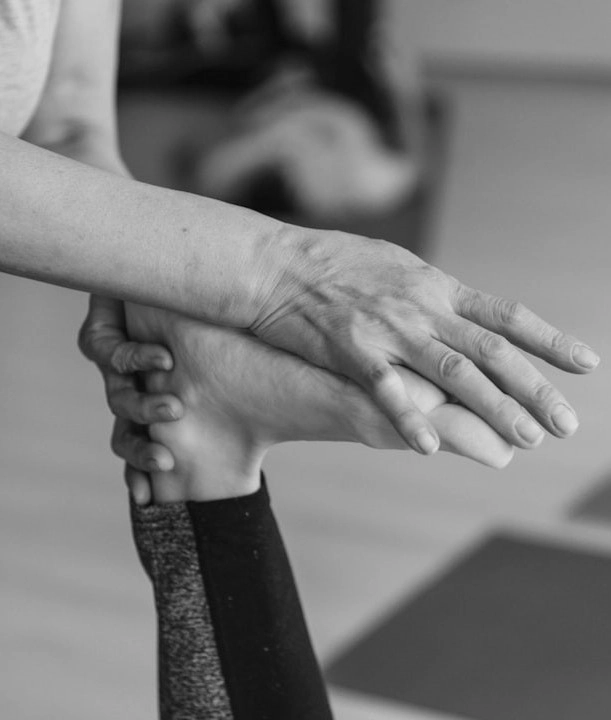
Trauma is not what happens with us,
but within us
- Gabor Maté -
Moving between safety and danger
Throughout the day, the body scans the environment for signals of safety and danger. This process is known as 'neuroception'. Based on internal and external information, the autonomic nervous system triggers reactions in the body by releasing hormones, adjusting oxygen levels, directing blood to certain areas or changing muscle tension. In a healthy system, activation and relaxation follow each other organically. This allows us to shape and face life with appropriate energy. This happens naturally, in the background and mostly without us being aware of it. Trauma can disturb this ability.

Bodily perspective on Trauma
When we are under threat our body mobilises a great deal of energy. If the body's instinctive fight-or-flight response is unsuccessful, it gets interrupted and can't be completed. In some cases, the autonomic nervous system switches to a (partial) freezing state to prevent further pain. The mobilised energy and response are not (fully) expressed. In this sense, it can be said thta a traumatic event goes beyond our capacity to protect ourselves, which leads to an experience of overwelm. Something is too hard, too fast, too long, too early or too confusing, to name but a few. In these events the energy that is mobilised and the imcompleted response get often linked to a form of anxiety.
As such trauma leaves its mark in the body, distorting the perception of daily life by disrupting the nervous system and overall physical functioning and well-being. Characteristically, there is an inability to respond appropriately to (certain situations in) life. For example, energy and the ability to think clearly may suddenly diminish under specific circumstances, or something minor may happen that triggers a violent outburst of anger or an attempt to escape. A range of vague symptoms that cannot be explained medically and blockages in the musculoskeletal system can also indicate trauma marks in the body.
What actually takes place is that the amygdala, a kind of safety centre in the limbic brain, sounds the alarm at the wrong times (or not at all) based on the previous overwhelm and coupelling to fear. The limbic brain, also referred to as the emotional brain, is responsible for regulating emotions, learning, memory and driving motivation and behaviour. When alarmed, it causes the so-called reptilian brain, which is responsible for primary functions such as breathing, heart rate, circulation and digestion, to produce a lot of energy or, on the contrary, to conserve a lot of energy. The neo-cortex, the part of our brain that enables us to think, organise and understand, has no influence on this. Therefore, talking and understanding are often not enough to get out of the grip of trauma because they cannot address the deeper autonomic dysregulation.
Renegotiate trauma with Somatic Experiencing™
Somatic Experiencing™ (SE) was developed by Peter Levine, PhD. In his research on stress and PTSD, he wondered why mammals, with a similar nervous system to humans, develop virtually no trauma. He found that a prey animal, which narrowly survives an encounter with a tiger, once in safety goes through a number of body processes, including twitching and shaking. In doing so, it literally shakes off the mortification of a freezing repsonse, regulates breathing and discharges residual energy from flight or fight activation. This process is controlled by the autonomic nervous system. Trauma in humans tends to occur when phases in this natural discharge process are skipped, because, for example, people are shocked by these spontaneous and sometimes intense body reactions or are ashamed of them and hold back. It also happens that the danger remains present in situations at home, at school, at work or in the community.
In his practice, Levine discovered how a safe, calm environment and contact with an engaged other allows the body to complete earlier defences and still release the disruptive energy.
Somatic Experiencing™ supports clients in the development of body awareness and resources that give the nervous system resilience before working with the intense energy of trauma. This is guided by the capacity and pace of the client. Trauma is approached in a titrated, step-by-step manner, making it manageable and preventing re-traumatisation. Clients learn to recognise the body's signals and to navigate more intense energy in a way that allows them to remain present (containment).

A typical Somatic Experiencing™ session moves between safety and the energy of trauma. Conversation, experience, moments of release and bits of psycho-social information alternate. Sometimes there are only a few words. As a result people experience an increase and deepening of their life energy, joy and ability to make connections with themselves and others.
Read more under Info & Fees ➝
Beyond the words
Soma Embodiment
Soma Embodiment was developed by Sonia Gômes - PhD and global teacher of Somatic Experiencing™. Gômes' approach supports the resilience of the nervous system through movement and touch, promotes overall self-regulation and makes non-verbal aspects of trauma more accessible.
From the moment of conception, the cells of our body orients themselves through gravity and touch. Trauma disrupts this natural process, which can cause us to lose our sense of place in life, both literally and figuratively. Soma Embodiment stimulates the body to regain it's sense of gravity, balance and associated spontaneous and regulated breathing - thus allowing the internal body signals to have better reception. Physically (re)finding our ground leads to relaxation and provides a basis for standing up again and engaging in the horizontal, social aspects of life. Together with you I will explore where (gravitational) force can be experienced in the body, in which directions things are held and what is released when the body is supported to move again.
Soma Embodiment can flow together with a SE session, but can also be used preventively with a series of regulatory exercises that you can do by yourself, in duo's or as part of a team.
Questions about SOMA applications? get in touch! ➝

A typical Soma Embodiment session begins with a (short) conversation, followed by working with grounding, movement and touch. Materials such as balls, sticks and sandbags are also used to enhance experience and stimulate bodily responses. The work is mainly done while sitting and standing, but sometimes also laying on a (massage) table or mat. There will be a careful consultation with you as the client about the (way of) touch, the right tempo and what the body is 'telling'.
Read more under Info & Fees ➝

Trauma resources
If you want to learn more about trauma and the work of pioneers like Peter Levine, Stephen Porges, Gabor Mate, Bessel van der Kolk and others, these articles, podcasts and lectures might be just what you are looking for!


